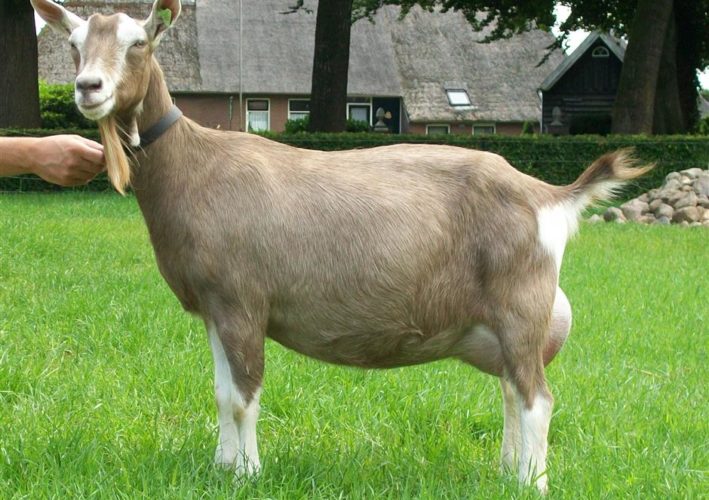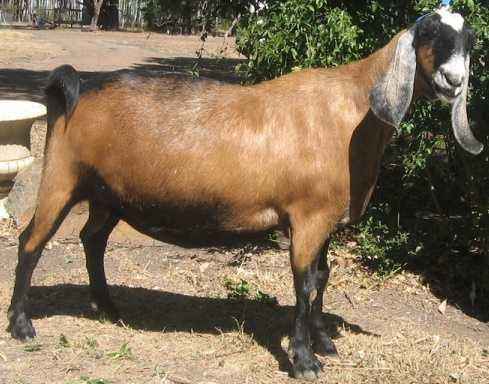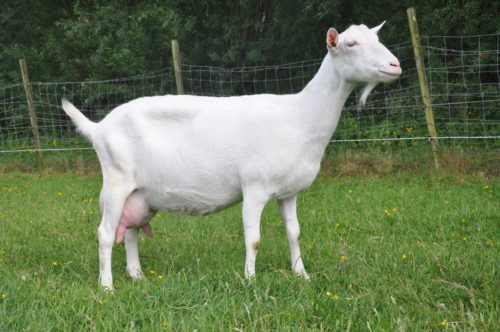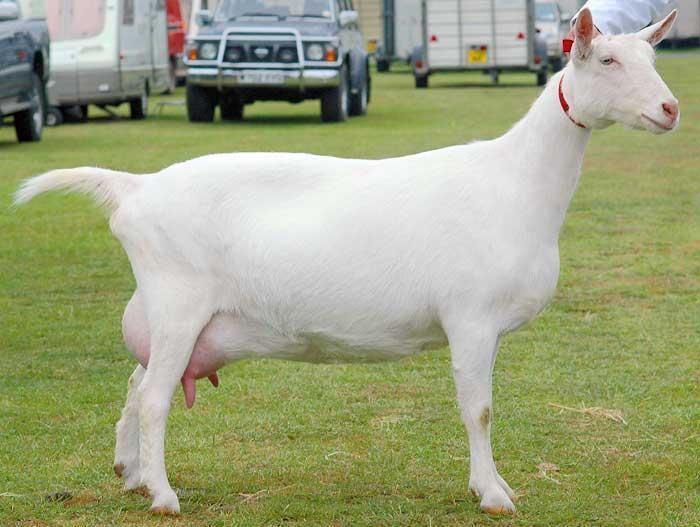The Netherlands is known worldwide for their agricultural achievements. Through thorough breeding and selecting the best genetic lineages, Goavity is able to provide the best possible semen, tailored to your personal circumstances and needs.
Anglo-Nubian Goat
The main identifying feature of this breed is the head, which has a pronounced “roman” nose and long drooping ears. The goat has a long deep body and an upright stance. The large number of colour variations, in the short silky coat, adds to the breeds’ attractions.
An average 24 hours yield of 3.89 Kg. at 4.84% butterfat and 3.51% protein was obtained by considering data from all Anglo Nubians entered in B.G.S. recognised milking trials in a recent year (467 performances). The milk is ideal for yoghurt and cheese making.
The breed is also well suited to meat production, both in its own right and when crossed with other breeds. It adapts well to hot climates and has resulted in demand for exports to increase both milk and meat production.
Dutch Saanen
The Saanengoat is the largest of the dairy goat breeds. Growing to 130 to 145 pounds, theSaanen breed is one of the best goats for milk. This breed is a consistenthigh-volume and high-quality milk producer. It’s no wonder that the friendlySaanen goat has risen to the favorite position with many goat owners.
The Saanengoat, (Capra aegagrus hircus), originated in the Saanen Valley of Switzerland.They were first brought to the USA in 1904. Later arrivals from England joinedherds, in the 1960s. The Saanen goat quickly became a favorite in milking goatherds. They joined Toggenberg, Nubian, LaManchas, Alpine, Oberhasli, andNigerian Dwarf goats in the goat milk market.
Saanengoats bring their own unique characteristics of high milk production with lowerbutterfat percentage. The butterfat percentage is usually in the 3.5% range.The average milk production of a Saanen goat doe is 2545 pounds of milk peryear.
Saanens areall white. Some spots are permissible but not desirable in the show ring.Colored Saanens are now referred to as Sables and are now a recognized breed.The hair of the Saanen goat is short and white and the skin color should be tanor white.
This breedis a good choice for children and beginners in the goat world. Saanens possessa calm temperament. You often hear the terms hardy, calm and sweet used todescribe the breed. At over 30 inches tall and with considerable weight, the Saanencould be considered the gentle giant of the goat world.
Saanengoats are tolerant of many climates and take change in stride. Due to their tanor light skin, available shade is a must for Saanen goats. Some feel that thisbreed produces better in cooler climates but that does not seem to hold true.The Saanen goat breed seems to thrive and have high production in almost everyarea, as long as their needs for shade, shelter, pasture or quality hay andfresh clean water are made available.
After beingimported to the United States in the early part of the twentieth century, theSaanen goat breeders were hit hard by the Depression in the 1930’s. Many goatbreeders were forced to go out of business and many goat dairies closed. TheSaanen goat breed was revitalized by importing goats from England in the 1940’sthrough the 1960’s. Many of these European goats had to take a roundabout tripto the United States through Canada. The USDA at the time was not in favor ofimporting animals from Europe. The animals could be imported to Canada though,and after a time there, could be imported to the USA. The Saanen goat breederswho persevered through the depression liked the look of the Brittish Saanen andbrought quality back to the breed by introducing these new lines. Many of thefamilies that survived the early years and the depression continued to improvethe breed to today’s standards. Today’s Saanen goat is a powerhouse of milkproduction, stamina, temperament, hardiness and disease-resistance.
There aremany compelling reasons for raising dairy goats. Perhaps you’re intrigued bygoat milk benefits, making goat cheese, or learning how to make goat milk soap.Whether you want to raise a small herd for your personal or family needs or areinterested in raising goats for profit, you’ll find these creatures to befriendly, docile, curious and intelligent.
British Toggenburger
The Toggenburg goat is one of six major dairy goat breeds in the U.S. and has international recognition.
Origin: In the Toggenburg region of St. Gallen, Switzerland, in the valley of the jaggedChurfirsten mountains, the local goats had shaggy dark coats, often with whitepatches. In the nineteenth century, interest in defining regional breeds led toselection for color and markings. Local goats are thought to have been crossed with the neighboring white Appenzell and bay/black Chamois-colored goats. By1890, the Toggenburg breed was recognized and a herdbook opened. Color,markings, conformation, and polled traits were further selected during thetwentieth century to produce the distinctive appearance we know today.
Alpine farmers keep small herds to graze with their cows for pasture maintenance, as they eat many plants ignored by cattle. Goats also spend the summer foraging in the Alpsto maintain the landscape.
History: The breed became popular due to strong limbs, well-formed udder and teats, andengaging nature. It spread throughout Switzerland and to other European countries and abroad, becoming an international dairy breed. Several imports into Britain during the late nineteenth century established Toggenburg as the first breed to have its own section of the herdbook in 1905. Herdbooks have been established in several countries, such as Belgium, Austria, Australia,South Africa, and Canada. Toggenburg exports have also formed the basis ofother national breeds, such as the British Toggenburg, Dutch Toggenburg, and the Thuringian Forest goat in Germany..
In the United States, selective breeding for dairy started in 1879, using the descendants of animals brought over by settlers. Breeders wishing to enter their animals into the St. Louis World’s Fair (1904) required verifiable registrations, leading to imports of already established breeds. The first improved dairy goats were imported from England in 1893 by William A. Shafor. He became the secretary, and later president, of the American Milch Goat Record Association (AMGRA, which later became the ADGA). This first import was of four purebred Toggenburgs, whose offspring became the first entry registered in the AMGRA herdbook in 1904. Then, sixteen Toggenburgs were imported from Switzerland in 1904 (together with ten Saanens) for four buyers. One was the young William J. Cohill from Maryland, who exhibited his goats at the St. Louisevent as the only dairy goat entry.
Conservation Status: Swiss goats suffered a population decline during the twentieth century,resulting in endangered status. The FAO lists Toggenburgs as vulnerable inSwitzerland, although not at risk worldwide. In 2020, 3120 females and 183 males were registered in Switzerland, but nationwide population estimates are up to6500. The U.S. has at least 2000 registered.
Biodiversity:Before the establishment of herdbooks in Switzerland, neighboring landraceswould frequently interbreed, leading to a wide common gene pool between Swissbreeds. However, genetic analysis has revealed a clearly defined gene pool forToggenburg and a low rate of inbreeding within Switzerland. Exportedpopulations are more prone to inbreeding: the U.S. average inbreedingcoefficient was 12% by 2013, which is the equivalent of first cousins.
Description: Toggenburgs are smaller than most dairy breeds, sturdily built with strong legs and an elongated body. The forehead is wide, muzzle broad, and facial profile straight or slightly dished. Polled individuals are common; otherwise horns curve upwards and backwards. Both sexes have beards, wattles are common, and ears are erect. The udder has excellent conformation, being well-attached and compact, with correct teats. The coat is smooth, short to medium in length, with a longer, paler fringe along the back and hindquarters. Short-haired types are more common in the U.S.
Coloring: Light fawn or mouse gray to dark chocolate; white lower limbs, ears, root of wattles, and facial stripes from the base of horns to the muzzle; white triangle either side of the tail.
Height to Withers: Bucks 28–33 in. (70–85 cm); does 26–30 in. (66–75 cm).
Weight: Does from 120 lb. (55 kg); bucks 150 lb. (68 kg).
Sturdy Milker and Delightful Companion
Popular Use: Commercial and homestead dairy and pets.
Productivity: In Switzerland, yearly averages are 1713 lb. (777 kg) over 268 days with 3.5%fat and 2.5% protein. ADGA averages for 2019 are 2237 lb. (1015 kg) with 3.1%fat and 2.9% protein. Annual yield can range between 1090 lb. (495 kg) and 3840lb. (1742 kg). The low fat percentage does not give high yields of cheese. However, some producers claim strong and distinctive flavors, which can help improve cheese character. Flavor is variable and greatly influenced by diet.
Temperament: Their bold, lively, and curious nature makes them good pets and homestead milkers. They have little fear of other animals and prefer living in small groups.
Adaptability: They are widely adaptable, but prefer cooler conditions. Milk yield and flavor is better if they can range extensively on a variety of forage.
British Saanen
This is a white goat, developed in the UK and largely influenced by imported Saanen goats. The white coat is short and fine, but freckles and patches of colour are allowed on the skin. Registered pure bred Saanens can be used with British Saanens and the progeny can still be registered as British Saanen. Goats of this breed have longer legs than the Saanen, and are heavier. Generally they have calm natures with high yields and long lactations.
It is a popular breed for those requiring high production of liquid milk throughout the year and where large groups of goats may be housed together. For these reasons the British Saanen forms the foundation breeding stock for some large goatfarms in the UK, where liquid milk sales are the main objective.
An average 24 hour yield of 5.17 Kg. at 3.48% butterfat and 2.61% protein was obtained by considering data from all British Saanens entered in B.G.S. recognised milking trials in a recent year (545 performances).
British Alpine
This goat is black with white Swiss markings and has been developed in the UK. The goat should be rangy with a short fine coat. The overall effect is a most impressive animal when the black coat acquires its summer gloss. The breed can be highly individual in character and tends to be a breed for enthusiasts who like a challenge.
British Alpines generally have long lactations. An average 24 hour yield of 4.09 Kg. at3.77% butterfat and 2.74% protein was obtained by considering data from all British Alpines entered in B.G.S. recognised milking trials in a recent year (459 performances).




